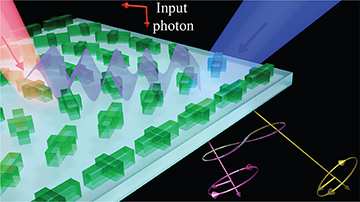Researchers at Los Alamos National Laboratory, USA, have shown how interference between two pump lasers could modulate the refractive index of a metasurface so as to entangle the spin, path and frequency of a single probe photon. [Image: LANL] [Enlarge image]
Being able to rapidly manipulate the quantum properties of photons using compact, chip-based devices could enhance or open up a raft of technological applications, from high-speed quantum communications to novel forms of propulsion.
That is the vision of scientists at the Los Alamos National Laboratory, USA, who have devised a new type of quantum-based metasurface that can continuously tune light–matter interactions in space and time. The researchers have shown that such metasurfaces could allow single photons to be entangled on demand, or could convert photons in the quantum vacuum from virtual particles into real ones (Phys. Rev. Lett., doi: 10.1103/PhysRevLett.127.043603).
Dynamic and quantum-enabled
A metasurface consists of an extremely thin, dense array of tiny antennas that can tune the amplitude, phase or polarization of incoming light waves. When originally developed in 2011, metasurfaces provided an alternative to bulky optical components, but they were static devices whose light-altering properties were fixed during manufacturing. Over the last year few years, in contrast, scientists have built dynamic versions with structures that vary in time as well as space—allowing wavelength conversion, beam steering and other previously unattainable effects (see “Tunable Metasurfaces,” OPN, July/August 2021).
What’s more, researchers have also demonstrated how metasurfaces can manipulate quantum as opposed to classical beams of light. These devices consist of quantum elements—be they quantized materials, emitters or light—that are sometimes combined with classical components.
In the latest work, Diego Dalvit, Wilton Kort-Kamp and Abul Azad at Los Alamos have combined the dynamic and quantum innovations to yield a concept they call “space–time quantum metasurfaces.” Such devices, they say, would allow arbitrary control of the spectral, spatial and spin properties of nonclassical light. And the team has calculated in detail how two varieties of such metasurfaces might operate.
Generating “hyper-entanglement”
The first case involves quantum light interacting with a classical material—an array of high-refractive-index dielectric antennas, or “meta-atoms,” shaped like crosses and arranged in a curved layout. The scheme exploits a spatiotemporal variation in the refractive index demonstrated classically two years ago by a group at Pennsylvania State University, USA, that involves two slightly detuned pump lasers and a probe laser. Interference between the former generates a travelling wave of index modulation that is used to tailor the quantum parameters of the latter.
The researchers argue that when the travelling wave’s geometric phase, which is fixed by the design of the metasurface, varies in proportion to the position of the meta-atoms, it generates correlations between the probe photon’s spin and its path. Conversely, proportionality between the synthetic phase (determined by the space–time modulation) and the meta-atom position yields correlations between frequency and path. The upshot, according to the team, is that the photon evolves into a state that is hyper-entangled in spin, path and frequency.
The upshot, according to the team, is that the photon evolves into a state that is hyper-entangled in spin, path and frequency.
Such laser-based modulation, the researchers suggest, might be used to create reconfigurable hyper-entanglement for high-bandwidth quantum communications. Another possible use would be in active quantum sensors that exploit a steered photon beam to scan a given detection area.
Harvesting photons from quantum vacuum
The second metasurface concept studied by the Los Alamos team involves not a classical material but a quantum one: an array of graphene disks whose electric polarizability is modulated at terahertz frequencies (something which could be done optically or, conceivably, electrically). This modulation couples the metasurface to the quantum vacuum, creating a process akin to the dynamic Casimir effect. In other words, individual “virtual photons” are separated from their partners before they have time to combine—resulting in two streams of real photons travelling away from the surface.
Dalvit and colleagues say that by tailoring the synthetic phase, it would be possible to fire photons off so that they yield a net momentum in a particular direction. This would generate propulsion, which they say could lead to a new type of mechanical thruster for propelling nanoscale objects, for example. They add that the modulation process could also add orbital angular momentum, which, they say, would result in entangled pairs of “vortex” photons.
Next step: Building the surfaces
Dalvit and colleagues are now working to build these metasurfaces in the lab, but will need to overcome a number of technical hurdles before they have working devices. These, they say, include the need for minimal photon absorption, high-speed response and low-noise modulations (to prevent decoherence). Further, they add, it will be necessary to address huge numbers of individual unit cells—which, as for new generations of electronic chips, poses problems of integration and power consumption.

